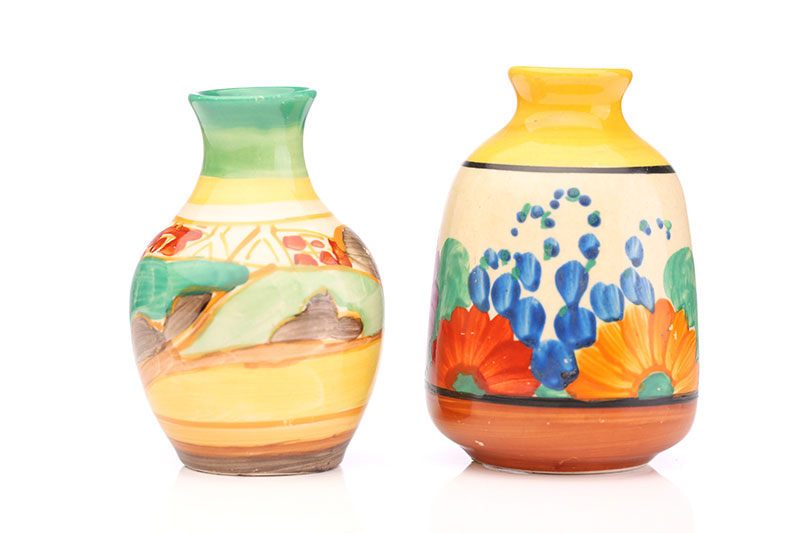Is Clarice Cliff Still Collectable?
A closer look at Clarice Cliff's Ceramics
08/04/2024
Renowned British ceramicist, Clarice Cliff, gained fame for her vibrant and innovative designs during the Art Deco period in the 1920s and 1930s. Cliff's distinctive style, characterised by bold colours and geometric patterns, set her work apart from traditional ceramics of the time.
Born in Tunstall in 1899, Cliff joined the potters when she was just thirteen years old. Traditionally in the 1800s, once young women mastered a particular task, they would stick with it to maximise earnings. However, Cliff was far too ambitious to focus on just the one skill, and after she mastered gilding, she went on to learn hand painting, outlining, enamelling, banding, and modelling, as well as keeping her own pattern book.
Two Clarice Cliff miniature vases
Indeed, Cliff had successfully completed two apprenticeships by 1927, when the owners of Wilkinson’s gave her a studio in the Newport Pottery. During this time, she worked on “ghost” pieces, creatively covering imperfections with patterns in a style she called “Bizarre”. Cliff reached the height of her career in the 1930s, trailblazing her way with non-conformist designs in an array of outrageous colours.
However, the onset of World War II in 1939 brought strict restrictions on pottery, with a total ban on decorated wares in 1942. As such, Cliff was unable to continue her design work and when the war was over, tastes had shifted towards more conservative wares. Although her career in design had ended, she continued to run and co-own the factory with her husband Colley Shorter, until his death in 1963. The following year she sold the factory and retired.
In our modern society, it is difficult to appreciate the informal barriers she broke through to achieve her success. Careerwomen were extremely rare in the early 20th century and the publicity Cliff gained was unprecedented. At the height of her popularity, Clarice Cliff's pieces were sought after for their unique aesthetic appeal and artistic value. Collectors prized her pottery for its striking designs that captured the spirit of the era.
A 1930s Clarice Cliff conical sugar sifter
Exhibitions held at Brighton Museum in 1972 and the London gallery L'Odeon in 1976 would be the catalysts for a revival of interest in Clarice Cliff pottery. By the 1980s her pieces were generating a renewed excitement; numerous publications emerged, the Clarice Cliff collectors’ club was founded, and a documentary about Cliff’s team of paintresses was produced.
There remains a cult following of collectors for Clarice Cliff in today’s market, however, it is important to note that there are several factors that affect desirability and value. Condition will always have a bearing, Cliff's overglaze hand-painted decoration is especially prone to flaking. The combination of shape and pattern will determine the demand and value, rare examples command five figure sums, while collections that were produced in quantity allow entry level collectors to obtain a Clarice Cliff work of art, such as the Celtic Harvest range or Crocus pattern, for under £500. Enthusiasts and serious collectors tend to favour the most outwardly avant-garde Art Deco styles.
A 1930s Clarice Cliff conical sugar sifter
Highly sought after examples of Clarice Cliff works include the Age of Jazz flat-back figurines, the geometric face mask designed by Ron Birks and the Lido Lady ashtray. As well as unrecorded experimental pieces, coveted shapes feature the conical sugar sifters, prow of a ship shaped vases, Stamford-shaped teapots and YoYo vases. Whilst the most desirable patterns are the May Avenue pattern, the Appliqué range (1930-31), and the Sunspots pattern (only 20 examples have been discovered).
Read more
Do you have any Clarice Cliff pottery that you are considering selling?
With a huge global audience of potential buyers, Dawsons can achieve the best prices at auction.
Get in touch with an expert valuer for confidential sales advice today, we would be delighted to help:


